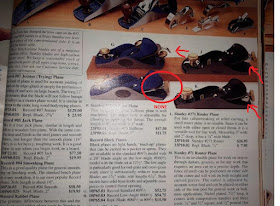What I found inside with the short note.
The two Millers Falls planes and a yet to be identified saw set. A MF No 4 Bullnose plane (Stanley No 75). The No 85 (Stanley 78) has the fence but no rod, a broken cap and a replacement made from a solid chunk of copper (heavy :-) and a strange unidentified U shape piece of metal???
Very cool, thank you Denis.
Lets have a closer look at the Millers Falls which are copies of older Stanley designs.
MILLERS FALLS No 85 (Stanley No 78) Duplex rabbet fillister plane.
Its called Duplex, because there are two location for the cutter. Up front as a Bullnose plane, rear position as a rabbet plane. The fence can pass under the sole making it a Fillister plane
The earliest Craftsman (Sears) were made by Sargent and the later ones by Millers Falls.
Essentially a copy of the Stanley, with a few twist. I suppose they just could not resist changing something??
I fetched one of my No 78 (I have two Stanley plus two Record 078)
The fences looks very much the same
This Stanley No 78 being blue is from the 70s
My replacement fence (Older Stanley black)
Surprise, the rod fit perfectly and so does the fence
Well that's interesting, the MF fence fit my rod perfectly, while...
... the so called Stanley fence does not.
My fence for the Stanley is a replacement part, I got that plane years ago without a depth stop, rod and fence. I have since acquired more of these planes and spare parts along the way. Problems with spare parts is that Stanley, Millers Falls, Sargent, Record, Ohio and etc all made similar tools. But they stopped at being similar. There are a few quirks between them making parts ID difficult at time.
These two fences and rods are interchangeable, but the screw to tighten the fence on the rod are different. I know from my spare parts inventory that there are variation in threads pitch, OD of rods etc Not quite sure yet, which is which??
In this example Stanley (?) and MF. They differ both in style, length and thread pitch.
Top, believed to be Stanley, bottom, MF.
Threads on the MF are a bit finer, screw goes in and turn but quickly jam.
I did not measured them but there is about 1 TPI differences.
Close, but no cigar!
What else is different? The body casting look pretty similar.
The twisted adjuster lever for depth of cut are different.
MF on Left, Stanley on Right
Here is another difference
The screw holding the chip breaker cap are different.
The larger one is the MF
What about the blades?
Very similar but look at the placement of the slot for the screw.
Left Stanley (offset) Right MF (centered).
Overlay they have just about the same dimensions, save for the slot location.
MF logo, tool steel blade
The MF blade in the Stanley body, pushed as far to one side as possible.
Flush on one side...
Flush on the other. It fits
The Stanley blade in the MF
Definite gap on this side, unable to move blade further on this side.
Does not work.
Interesting differences, glad to have yet another sample to compare on the variations.
All that to say these parts (fence, rod, depth stop) are often missing with this type of planes. You can find replacement parts here, that is where I get my spare parts usually.
But as you can see there is a few variations in screws threads, size, pitch rods OD and threads etc, etc.
Correct identification is not always easy, and they are sometimes confused between all the various makers. Buyer beware!!
Its original chip breaker cap was broken and shows signs of having been attempted to repair with an unsound weld. Very difficult to successfully weld cast iron. Guessing it failed during the weld clean up.
It was my friend Denis who made the replacement cap out of a single chunk of copper.
Besides being obviously thick, there are two small differences which will impact how it work.
First the nose where the chip curls up is rounded but very thick, the other is the lack of a small raised curve lip on the inside which is meant to curl the shaving outward. I have not tried it yet, but these two small differences I am guessing will cause the shavings to jam in the throat.
Mind you that type of plane has already a tendency to jam easily, your hands position will help or worsen the situation.
See the small up ridge on the RHS of the Stanley cap (blue).
It is designed to turn the shaving, so they exit up and away toward the other side
Broken original cap. Shows signs of a previous weld repair that did not take.
Interestingly, this one shows no signs of ever having that small up turned ridge on one side
You can really see that upturned lip on this Sargent No 79 cap (clone of Stanley No 78)
I am going to try to glue it back together.. Seen a new fangled UV cured glue that is suppose to be very strong. Will see. The product I want to try is called Bondic, or as they called it, its not a glue :-)
This product was invented by a Canadian dentist. There is a lot of pressure exerted on this location, curious to see if Bondic is up to it??
Other than that look and work just as good as the original Stanley, Record and etc.
A definite keeper. With a few spare parts, it will probably end up in one of my sons (now 3) tool kits.
Thanks a lot Denis, appreciated.
Bob, with something to blog for a change.
Been cleaning up and shredded lots of piles of paper lately. Fall clean up :-)



























































